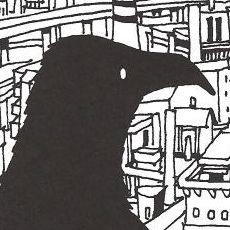Tag: science fiction
-
Basking in the inferno of Cloverfield, remembering Blue Gender
/
/ ReviewsRead More →: Basking in the inferno of Cloverfield, remembering Blue GenderHead-spinning, stomach-turning and mind-racing are a few of the adjectives I’d choose to describe how I felt when I stumbled out of the cinema last night, having just suffered through Cloverfield. To say I’d been looking forward to this film would be an understatement, and even though I’d only discovered its baffling trailer in early…
-
Another step Toward the Terra, circa 1980; old or not, it's still great
/
/ ReviewsRead More →: Another step Toward the Terra, circa 1980; old or not, it's still greatBe it 1980 or 2008, To Terra…. is just a wonderful story, a timeless one, even, that I can always watch or read and be completely lost in imagination.
-
The world is not beautiful, therefore it is; introducing Kino’s Journey
/
/ ReviewsRead More →: The world is not beautiful, therefore it is; introducing Kino’s JourneyI quite like subversive fairy-tales; the suggestion that there is something ugly and unknown shifting beneath a veneer of superficial beauty. This is precisely why I so admired Princess Tutu, because lurking behind that familiar style of magical girl characterization was insecurity and doubt; supposed heroes and villains stalked by emotions betraying their cliche destinies.…
-
You need to be watching Dennou Coil
/
/ ReviewsRead More →: You need to be watching Dennou CoilIn this so-called modern age, the thousands of miles that separate countries are irrelevant; a shrinking distance covered by mere flickers of electricity. Obviously, our world is merging and cultures are overlapping, yet the distance between you and I remains the same. Though we may have transcended the physical landscape, the emotional complexity of human…
-
Turn A Gundam and our attraction to self-destruction
/
/ ReviewsRead More →: Turn A Gundam and our attraction to self-destructionAs of writing, I’ve managed to sit through 28 episodes of Turn A Gundam; satisfied that I’m just over half way there. I won’t lie – it feels like an achievement because I’ve struggled through the series; at one point I literally had to stop an episode half-way and take an energy boosting nap, such…
-
"If I told you that I came from the future, would you laugh?" Review of The Girl Who Leapt Through Time
/
/ ReviewsRead More →: "If I told you that I came from the future, would you laugh?" Review of The Girl Who Leapt Through TimeIf a good movie is hard to come by, surely a good anime movie is like one in a million; what a relief then, because for now, my long search is over – The Girl Who Leapt Through Time is that one in a million. Dubbed in some quarters as the anti-Ghibli, it offers a…
-
From rambling to first impressions of Turn A Gundam
/
/ ReviewsRead More →: From rambling to first impressions of Turn A GundamMoans about anime blogging that somehow lead into my first impressions of Turn A Gundam. Yes, you read that right, please try to contain your excitement!
-
Please embrace the brilliance of Toward the Terra
/
/ ReviewsRead More →: Please embrace the brilliance of Toward the TerraI’m writing all this because I’m falling for Toward the Terra.
-
It's theEnd of the world! Reflecting on Eureka Seven!
/
/ ReviewsRead More →: It's theEnd of the world! Reflecting on Eureka Seven!It’s taken me two or three months, but today I finally finished watching Eureka Seven. Like whenever I finish reading a book or watching a long TV series, I feel like I’ve accomplished something big, but at the same time, I’ve grown attached to the Gekko-go and I’m not ready to wave good-bye. I adore…
-
Discovering Eureka Seven; mecha and dehumanisation
/
/ ReviewsRead More →: Discovering Eureka Seven; mecha and dehumanisationIn my previous E7 article, “Discovering Eureka Seven; subtext and pop culture“, I briefly touched on the pervasive themes of war laced through out the series, going so far as to compare it to Akitaro Daichi’s post-apocalyptic (underrated) masterpiece “Now and Then, Here and There“. As a genre, we’re conditioned to believe animation is for…
